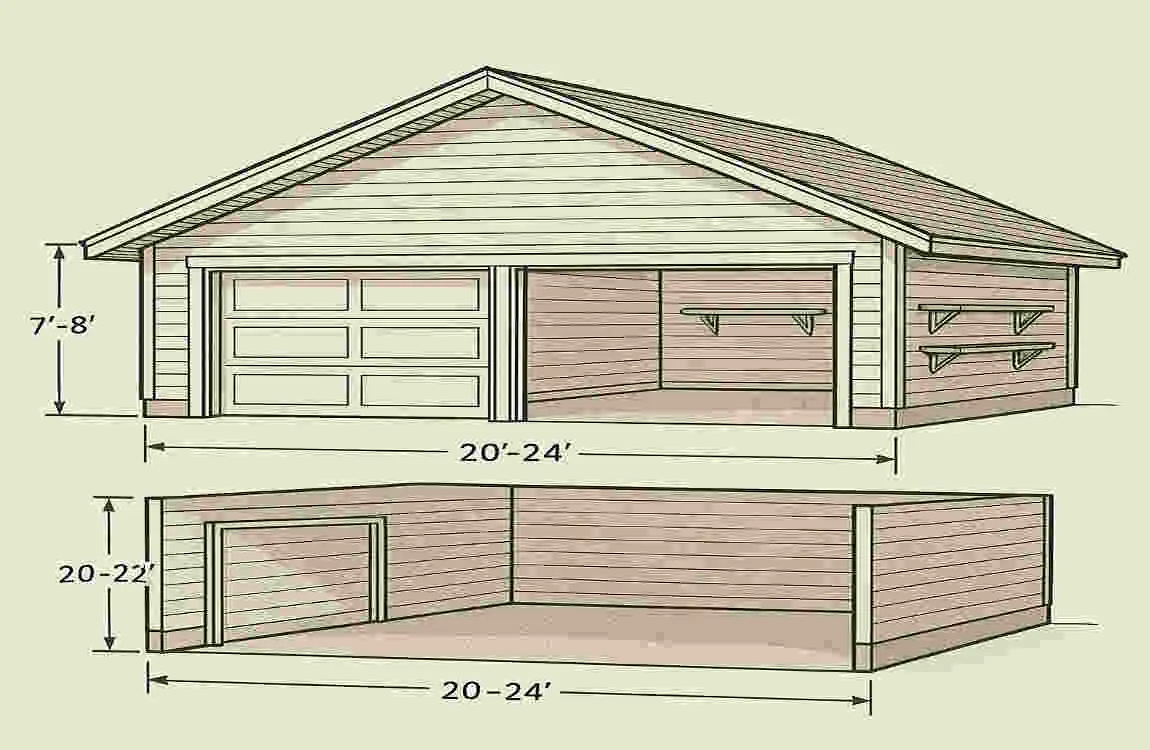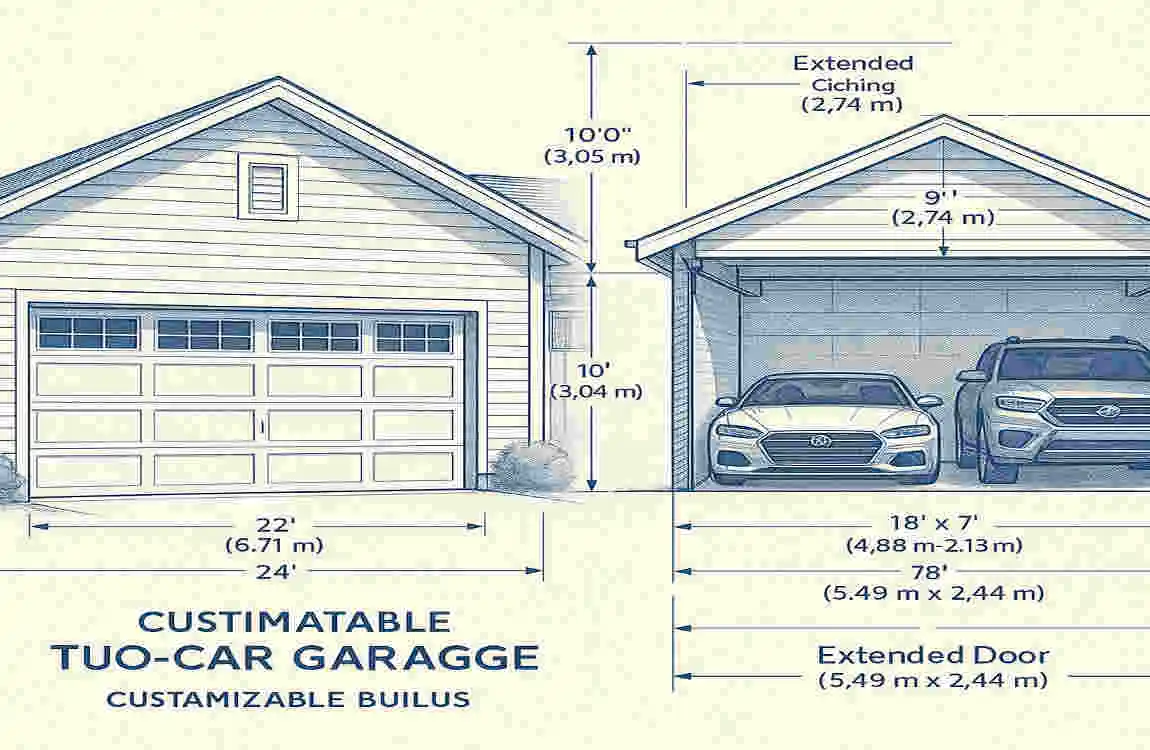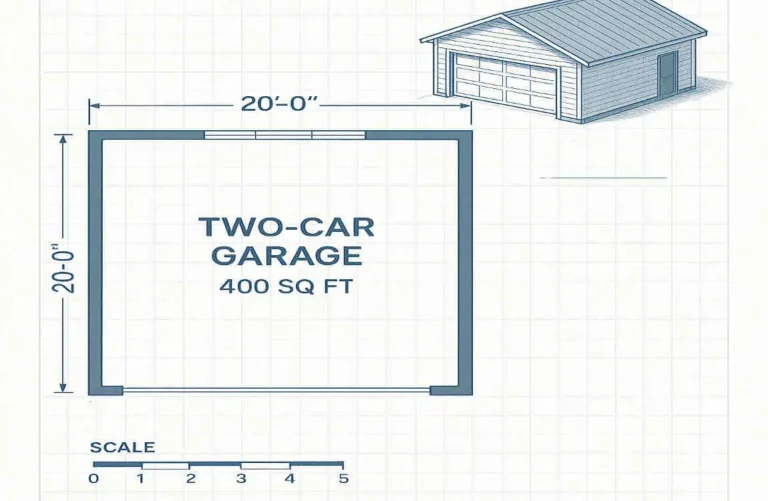Hey there, reader! If you’re scratching your head, wondering how many square feet a two-car garage is, you’re in the right spot. Whether you’re buying a new home, planning a renovation, or just daydreaming about that perfect setup for your vehicles, getting the size right can make a huge difference. A house garage isn’t just a place to park your cars—it’s often the unsung hero of home storage and hobbies.
What is a Two-Car Garage?

Imagine pulling into your driveway after a long day, and there’s a cozy spot waiting for not one, but two vehicles. That’s the magic of a two-car garage. At its core, it’s a structure designed to house two standard-sized cars side by side, keeping them safe from the elements, such as rain, snow, or that pesky bird that always aims for your hood.
But let’s be real—most folks don’t stop at just parking. These spaces often double as multi-purpose areas. Think about it: you could stash your bikes, lawnmowers, or holiday decorations there. Or turn it into a mini workshop for tinkering with projects.
Beyond Parking: Everyday Uses
You might use your garage for storage. Shelves lining the walls, boxes stacked neatly—it’s like an extension of your attic or basement. I’ve seen people transform theirs into home gyms, complete with weights and yoga mats.
What about hobbies? If you’re into woodworking or car repairs, that extra room becomes invaluable. It’s not uncommon for garages to host band practices or even small business operations. The point is, a two-car garage adapts to your lifestyle, making it more than just a car shelter.
Why It Matters for Homeowners
As a homeowner, you want functionality. A well-sized garage protects your investments—those cars aren’t cheap! Plus, it adds convenience. No more scraping ice off windshields in winter. Additionally, if you plan to sell your home later, a spacious garage can be a significant selling point. We’ll explore that more later.
Standard Dimensions and Square Footage of a Two-Car Garage
Now, let’s get to the heart of it: how many square feet is a two-car garage? The answer isn’t one-size-fits-all, but specific standard measurements recur frequently. Most builders stick to a few reliable options to ensure cars fit comfortably without feeling crammed.
Typically, these garages range in size from approximately 400 to 720 square feet. That might sound like a lot, but remember, it’s all about the layout. A smaller one might work for compact cars, while larger vehicles need more elbow room.
Standard Size Examples
Let’s break it down with specifics. A common starting point is the 20×20-foot garage. Multiply that out—20 times 20 equals 400 square feet. It’s compact and budget-friendly, making it perfect for city lots where space is limited.
Next up, the 24×24 foot version increases the area to 576 square feet. This is like the Goldilocks size—not too small, not too big. It provides you with enough room to open doors without damaging the walls.
For something roomier, consider a 24×30-foot garage, which measures 720 square feet. That’s ideal if you have an SUV or want space for extras, such as a workbench.
Minimum Sizes and Compromises
Experts often recommend at least 20×20 feet as a minimum, but honestly, that can feel snug. If your cars are on the larger side, you might struggle to maneuver. Compromises? You could lose storage space or end up parking one car outside. Think carefully—do you really want to squeeze in every time?
On the flip side, going bigger means more flexibility. But we’ll weigh the pros and cons soon. For now, measure your vehicles and see what fits your needs.
Factors Influencing the Size of a Two-Car Garage
Choosing the right garage size isn’t random; several factors influence the decision. You wouldn’t buy shoes without trying them on. Same idea here. Let’s unpack what might sway your decision.
First off, consider your vehicles. Are you driving zippy sedans or hefty trucks? That makes a world of difference.
Vehicle Size and Types
Compact cars easily slip into smaller spaces. A standard sedan typically requires approximately 10 feet of width per car, plus some additional buffer space. However, if you have a pickup or SUV, add a few feet to the measurement. Trucks can be over 7 feet wide, so a 24-foot width becomes essential to avoid scrapes.
What about electric vehicles or hybrids? They often come with charging stations, which might require extra wall space. Think ahead—your next car could be bigger.
Storage and Additional Uses
Do you need room for bikes, tools, or seasonal gear? Extra depth—like going from 20 to 24 feet—can create a whole storage zone at the back. Imagine shelves filled with paint cans or holiday lights, all neatly organized and out of sight.
If you’re turning it into a workshop, factor in space for benches and equipment. A few extra square feet here prevent clutter and make the space enjoyable.
Local Regulations and Property Limits
Don’t forget the rules! Local building codes might dictate minimum sizes or setbacks from property lines. In some areas, you need permits for anything over a certain footage. Check with your city hall to avoid headaches.
Your lot size matters too. A narrow yard might necessitate a slimmer large garage, while a spacious one allows for a larger one. Personal tastes? If you love hosting barbecues, consider integrating a side door for easy access.
Planning for the Future
Life changes—kids grow up, hobbies evolve. What if you buy a boat or RV someday? Building with foresight saves money later. Ask yourself: Will this size still work in five years?
How to Measure or Calculate the Square Footage of Your Garage
Okay, reader, let’s get hands-on. Want to know how many square feet a two-car garage is in your own home? Measuring is straightforward, but accuracy counts. Grab a tape measure and let’s do this step by step.
Start by clearing the space. Clear away cars and clutter so you can access every corner.
Step-by-Step Measurement Guide
First, measure the length. Run your tape from the back wall to the front, inside the garage. Note it down—say it’s 24 feet.
Next, tackle the width. From one side wall to the other, again inside. Let’s say 24 feet here, too.
To calculate square footage, multiply length by width. 24 x 24? That’s 576 square feet. Easy peasy!
Inside vs. Door Openings
Here’s a tip: Always measure interior dimensions. The door opening might be narrower—typically 16 to 18 feet for a two-car setup—to account for the frame. But for total space, it’s the inside that matters.
If your garage has odd shapes, such as alcoves, measure them separately and add up the total. Pro tip: Use a laser measurer for precision if you’re tech-savvy.
Common Calculation Mistakes to Avoid
People often forget to subtract built-ins, like stairs or pillars. Don’t! Those eat into usable space. And double-check your math— a simple error could lead to buying the wrong storage units.
There you have it. Now you can size up your garage like a pro. Give it a try and see what you get!
Pros and Cons of Different Garage Sizes
Not all garage sizes are created equal. Each has upsides and downsides, depending on your needs. Let’s compare them to help you make a decision.
We’ll look at three popular options. Consider your daily routine as we proceed—does this align with your life?
The 20×20 Garage: Compact and Cozy
This 400-square-foot option shines for small lots or tight budgets. Pros: It’s affordable to build and heats up quickly in cold climates. You save on materials, too.
Cons: Space is tight. Two cars fit, but forget about storage or workshops. Opening doors might mean careful parking to avoid dings. It’s suitable for city dwellers with sedans, but not ideal for families with gear.
The 24×24 Garage: The Sweet Spot
At 576 square feet, this is a favorite. Pros: Room for most vehicles, plus some storage. You can add shelves or a small bench without feeling cramped. It’s versatile and boosts home value.
Cons: If you upgrade to larger trucks, it might feel snug. Costs more than the smaller version, but the functionality payoff is worth it for many.
The 24×30 and Larger: Spacious Freedom
Hitting 720 square feet or more, these are for those who want it all. Pros: Fits trucks efficiently, with ample room for hobbies or extra vehicles, such as motorcycles. Great for multi-generational homes.
Cons: Higher build costs, and it takes up more yard space. Heating and maintenance can add up. But if you love projects, this is your dream.
To sum it up, smaller means savings but less room; larger offers flexibility at a price. Which one calls you?
Here’s a quick list of key pros across sizes:
- Affordability: Smaller garages win here.
- Versatility: Mid-sized options strike the best balance.
- Storage Potential: Opt for a larger space for maximum flexibility.
And for a visual, check out this comparison table:
Garage Size Square Footage Best For Potential Drawbacks
20×20 ft 400 sq ft Compact cars, tight budgets Limited storage, tight fit
24×24 ft 576 sq ft Average families, some extras May not suit huge vehicles
24×30 ft 720 sq ft Trucks, workshops, storage Higher costs, more space needed
Customizing Your Two-Car Garage Size

Standard sizes are great, but what if you want something tailored? Customizing allows you to adjust dimensions to meet your exact needs. It’s like designing your own puzzle piece for your home.
Options abound—from modular kits to complete custom builds. Let’s explore how to make it yours.
Modular and Prefab Options
Prefabricated garages are a game-changer. They come in kits you assemble, often starting at standard sizes but with add-ons. Want to extend the depth? Easy—many companies offer modular extensions.
These are quicker to install than building from scratch, and they’re often cheaper. Brands like those from Sheds Unlimited provide customizable plans. You pick the size, doors, and even colors.
Adding Width or Depth
Need more width for wide vehicles? Bump it to 26 feet instead of 24. Depth additions, say from 24 to 28 feet, create space for a workbench at the back. Costs? Expect to pay an additional $50 to $100 per square foot, depending on the materials used.
Consider insulation or windows as well—these enhancements make the space more livable. However, factor in your budget; custom work can add up.
Designing for Specific Needs
If storage is key, incorporate built-in cabinets. For a workshop, add electrical outlets and lighting. What about accessibility? Wider doors or ramps for wheelchairs.
Think about your hobbies. A car enthusiast might want a lift area, while a gardener could use potting benches. Consult a designer—they’ll sketch plans that match your vision.
Customizing isn’t just about size; it’s about making the garage work for you. What’s one change you’d make to yours?
How Garage Size Affects Home Value and Functionality
A garage does more than shelter cars—it impacts your home’s worth and daily life. Let’s see how size plays a role in that.
Bigger isn’t always better, but it often adds appeal. Real estate pros say a well sized garage can boost your property value by 5-10%.
Impact on Property Value
In the market, buyers love garages. A two-car setup with ample space signals convenience. According to sites like Angi, homes with larger garages tend to sell faster, especially in suburbs where cars are prevalent.
If yours is undersized, it might deter families. On the flip side, an oversized one could feel like overkill in a small home. Balance is key—match it to your neighborhood.
Functionality Beyond Parking
Functionality? Oh, it’s enormous. A spacious garage becomes a hub for life. Host parties, store sports gear, or set up a home office. It’s multi-purpose magic.
Smaller ones limit this, forcing you to use other areas of your home. Larger ones encourage creativity—think art studios or fitness zones. How do you use yours?
Buyer Preferences in Real Estate
Buyers prioritize space for modern vehicles. Trucks and SUVs are popular, so 24×24 or bigger appeals. Storage is a big ask too—folks want room for life’s extras.
In hot markets, a customized garage stands out. It shows thoughtfulness, making your home more desirable. If you’re selling, be sure to highlight the square footage in your listings.
Practical Tips for Choosing the Right Size Garage
Ready to pick? Here are hands-on tips to guide you. Don’t rush—good planning pays off.
Assess your needs step by step. Measure, think ahead, and get advice.
Assess Your Vehicle Dimensions
Start with your cars. Measure their length, width, and height. Add 2-3 feet on each side for doors and walking space. Got a truck? Factor in the tailgate swing.
Use online tools from sites like JD Power to compare. This ensures a snug but comfortable fit.
Consider Storage and Workspace Needs
List what else you’ll store: Tools? Bikes? Create a rough sketch and allocate zones. If you need a workbench, add 4-6 feet of depth.
Think multifunctional: Could it double as a laundry area? Prioritize based on your routine.
Future-Proof Your Choice
Life evolves. Plan for bigger vehicles or family growth. A flexible size, such as 24×24, adapts well.
Budget for changes—modular designs allow expansions later.
Consult Experts
Talk to builders or architects. They are familiar with local codes and can offer cost-effective solutions. Sites like HomeTown Structures provide free quotes.
Join forums like Reddit’s homeowners thread for real stories. What worked for others?

